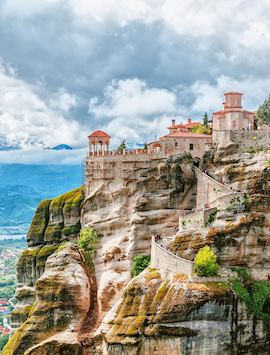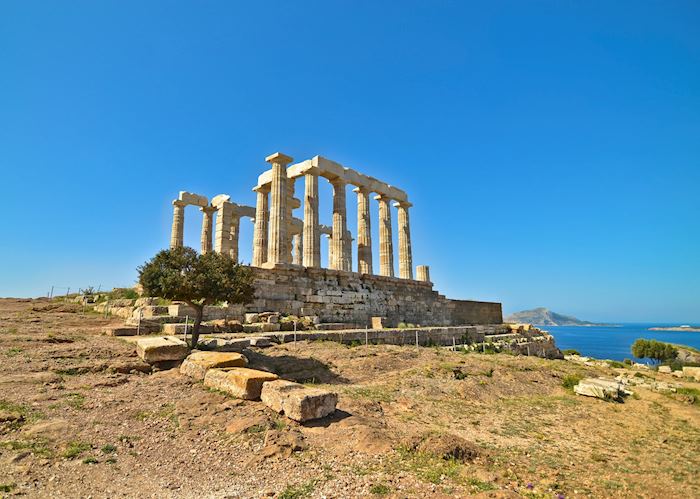Jump to:
Cape Sounion, at the southern tip of the Attica Peninsula, is a steeply ending headland looking out over the Aegean Sea and its many islands. At its head is the white-marble Temple of Poseidon, dedicated to the god of the sea and surrounded on three sides by water.
Scenically placed, well-preserved and close to Athens, the Temple of Poseidon offers an incredible sense of place, a sentiment captured by Lord Byron in his poem The Isles of Greece. A cluster of seafood restaurants and sandy beaches add to the appeal.
Built in 444 BC, during the Golden Age of Athens, the Temple of Poseidon sits atop an outcrop, surveying the sea. According to legend, this was the spot where Aegeus, king of Athens, flung himself into the water when he saw his son Theseus’s ship returning from Crete with black sails and mistakenly believed him dead. Theseus had agreed to fly a white sail had he successfully defeated the Minotaur but, distracted by love, forgot to switch it over.
The cape is a sacred site in many ways. When the Athenians defeated Xerxes in the Battle of Salamis in 480 BC, they placed a captured enemy warship on the headland and dedicated it to Poseidon.
Later, Pericles, the statesman responsible for rebuilding the Parthenon in Athens, commissioned a temple on the spot. He probably used Iktinos, the architect of the very similar Temple of Hephaestus in Athens' ancient Agora, to design the tribute to the sea god.
White marble for the temple was quarried nearby, giving it an arresting, bright appearance that made it an important landmark for sailors returning home. Originally, the temple had six white columns beneath the portico and a colonnade of columns on all sides.
Today, 16 of the original Doric columns remain, giving you a good impression of the size and scale of the newly built temple. Its setting, 60 m (200 ft) above the sea, is what lends it its undeniable drama and grandeur, though.
The views from the site are given over to the deep-blue sea and sky, only interrupted by the craggy tips of the islands of the Saronic Bay. On a clear day, the views from the site are far reaching, with the isle of Kea and the Peloponnese visible in the distance.
Lord Byron was so impressed by Sounion that he carved his name into one of the stones at the base of the temple. You can still find it among other graffiti of the age. At sunset, when the crowds have eased and the view across the water from the ruins glows a deep red, it’s easy to see why he was so taken with the place.
Nearby, the scant remains of the Temple of Athena stand on a low hill, built in 470 BC. The temple was destroyed in the 1st century AD, but you can still see its foundations. From here, a path leads down to a small sandy beach, though there are other larger beaches to the west.
Best time to visit Cape Sounion
You can visit Cape Sounion year-round, but it’s at its best between April and October, when warm weather and bright sunshine most enhance the setting. July and August are the busiest months, especially at weekends, and the hottest, with temperatures reaching 30°C (86°F).
who's been there
-
01993 838 92501993 838 027
- Make an enquiry
Suggested itinerary featuring Cape Sounion
This sample itinerary will give you an idea of what is possible when you travel in Cape Sounion, and showcases routes we know work particularly well. Treat this as inspiration, because your trip will be created uniquely by one of our specialists.
Places near Cape Sounion
- Athens 28 miles away
- Hydra 38 miles away
- The Peloponnese 45 miles away
- The Greek Islands 50 miles away
- Syros 53 miles away
- Sifnos 62 miles away
- Tinos 64 miles away
- Nafplio 67 miles away
- Milos 68 miles away
- Mykonos 74 miles away
- Paros 77 miles away
- Naxos 85 miles away
- Monemvasia 86 miles away
- Folegandros 87 miles away
- Arachova 97 miles away
- Delphi 101 miles away
- Galaxidi 103 miles away
- Santorini 118 miles away
- Olympia 131 miles away
- Costa Navarino 138 miles away
- Crete 173 miles away
- Meteora 193 miles away
- Thessaloniki 213 miles away
- Corfu 266 miles away







